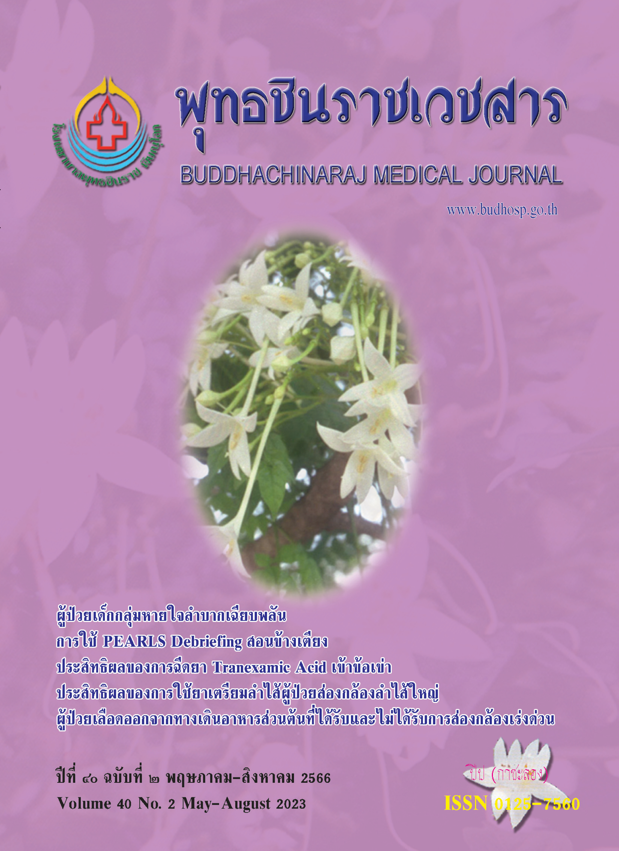การแยกความต่างของความมืด-สว่างขณะใส่เลนส์ตาเทียมชนิดแอสเฟียริกระหว่างผู้ป่วยที่มีโรคตาส่วนหลังและผู้ที่ไม่เป็นโรคตา
ความสามารถในการแยกความมืด-สว่างขณะใส่เลนส์ตาเทียมชนิดแอสเฟียริก
คำสำคัญ:
การแยกความต่างของความมืด-สว่าง, โรคตาส่วนหลัง, เลนส์ตาเทียมบทคัดย่อ
เลนส์ตาเทียมชนิดแอสเฟียริกมีส่วนในการเพิ่มคุณภาพการมองเห็น ด้วยการลดการกระเจิงแสงทำให้การแยกความต่างของความมืด-สว่างดีขึ้น การศึกษานี้จึงสนใจศึกษาข้อมูลของผู้ป่วยที่ใส่เลนส์ตาเทียมชนิดแอสเฟียริก โดยเปรียบเทียบการแยกความต่างของความมืด-สว่างระหว่างข้อมูลที่เป็นโรคตาส่วนหลังและไม่เป็นโรคตา การศึกษานี้เป็นแบบวิเคราะห์ย้อนหลัง ข้อมูลได้จากคลินิกจักษุแพทย์ มหาวิทยาลัยรังสิต ระหว่างปี พ.ศ. 2558-2562 แบ่งข้อมูลเป็น 2 กลุ่ม ได้แก่ ข้อมูลของผู้ป่วยที่มีโรคตาส่วนหลัง (16 ตา) และผู้ป่วยที่ไม่เป็นโรคตา (20 ตา) นำข้อมูลการแยกความต่างของความมืด-สว่างที่ทดสอบด้วยเครื่อง OPTEC 6500 vision tester ในสภาวะแสงที่ต่างกัน มาวิเคราห์โดยใช้สถิติ Mann-Whitney U test พบว่า สภาวะแสงสว่างที่มีแสงสะท้อน ในความถี่เชิงพื้นที่ 12 รอบ/องศา ข้อมูลที่เป็นโรคตาส่วนหลังมีค่าการแยกความต่างของความมืด-สว่างต่ำกว่าข้อมูลที่ไม่เป็นโรคตาอย่างมีนัยสำคัญ (p=0.034) ในขณะที่ไม่พบความต่างของอายุและระดับการมองเห็น จึงสรุปได้ว่า การใส่เลนส์ตาเทียมชนิดแอสเฟียริกอาจมีส่วนทำให้การแยกความต่างของความมืด-สว่างในผู้ป่วยโรคตาส่วนหลังกับผู้ไม่เป็นโรคตาไม่มีความแตกต่างอย่างมีนัยสำคัญ อย่างไรก็ตาม การมีโรคตาส่วนหลังยังสามารถส่งผลต่อการแยกความต่างของความมืด-สว่างได้ โดยพิจารณาจากค่าเฉลี่ยที่ต่ำกว่าผู้ที่ไม่เป็นโรคตา
เอกสารอ้างอิง
Sun Y, Erdem E, Lyu A, Zangalli C, Wizov SS, Lo D, et al. The SPARCS: A novel assessment of contrast sensitivity and its reliability in patients with corrected refractive error. Br J Ophthalmol 2016;100(10):1421-6.
Bambo MP, Ferrandez B, Güerri N, Fuertes I, Cameo B, Polo V, et al. Evaluation of contrast sensitivity, chromatic vision, and reding ability in patients with primary open angle glaucoma. J Ophthalmol 2016;2016:7074016. https://doi:10.1155/2016/7074016
Rao A, Pal A, Mohapatra S. Spaeth/Richman contrast sensitivity in staging glaucoma. Transl Vis Sci Technol 2020;9(13):39. https://doi: 10.1167/tvst.9.13.39
Owsley C, Huisingh C, Clark ME, Jackson GR, McGwin GJr. Comparison of visual function in older eyes in the earliest stages of age-related macular degeneration to those in normal macular health. Curr Eye Res 2016;41(2):266-72.
Pondorfer SG, Wintergerst MWM, Gorgi Zadeh S, Schultz T, Heinemann M, Holz FG, et al. Association of visual function measures with Drusen volume in early stages of age-related macular degeneration. Invest Ophthalmol Vis Sci 2020;61(3):55. https://doi: 10.1167/iovs.61.3.55
Kim B, Kwon S, Choi A, Jeon S. Influence of mild non-foveal involving epiretinal membrane on visual quality in eyes with multifocal intraocular lens implantation. Graefes Arch Clin Exp Ophthalmol 2021;259(9):2723-30.
Muñoz G, Albarrán-Diego C, Montés-Micó R, Rodríguez-Galietero A, Alió JL. Spherical aberration and contrast sensitivity after cataract surgery with the Tecnis Z9000 intraocular lens. J Cataract Refract Surg 2006;32(8):1320-7.
Montard R, Putz C, Creisson G, Montard M. Aberrometry and contrast sensitivity after cataract surgery: Aspheric IOL evaluation. J Fr Ophtalmol 2008;31(3):257-62.
Deshpande R, Satijia A, Dole K, Mangiraj V, Deshpande M. Effects on ocular aberration and contrast sensitivity after implantation of spherical and aspherical monofocal intraocular lens-A comparative study. Indian J Ophthalmol 2022;70(8):2862-5.
Tzelikis PF, Akaishi L, Trindade FC, Boteon JE. Spherical aberration and contrast sensitivity in eyes implanted with aspheric and spherical intraocular lenses: A comparative study. Am J Ophthalmol 2008;145(5):827-33.
Liu L, Wang Y, Liu J, Liu W. Retinal-image quality and contrast sensitivity function in eyes with epiretinal membrane: A cross-sectional observational clinical study. BMC Ophthalmol 2018;18(1):290. https://doi.org/10.1186/s12886-018-0957-1
Schwartz SH. Visual perception a clinical orientation. 4thed. New York City, New York State, USA: The McGraw-Hill Companies; 2010. p.179-80.
Li Z, Hu Y, Yu H, Li J, Yang X. Effect of age and refractive error on quick contrast sensitivity function in Chinese adults: A pilot study. Eye 2021;35(3):966-72.
Hashemi H, Khabazkhoob M, Jafarzadehpur E, Emamian MH, Shariati M, Fotouhi A. Contrast sensitivity evaluation in a population-based study in Shahroud, Iran. Ophthalmology 2012;119(3):541-6.
Tang Y, Zhou Y. Age-related decline of contrast sensitivity for second-order stimuli: Earlier onset, but slower progression, than for first- order stimuli. J Vis 2009;9(7):18. doi: https://doi.org/10.1167/9.7.18
McAnany JJ, Park JC, Liu K, Liu M, Chen YF, Chau FY, et al. Contrast sensitivity is associated with outer-retina thickness in early-stage diabetic retinopathy. Acta Ophthalmol 2020;98(2):e224-e231. https://doi: 10.1111/aos.14241
Pramanik S, Chowdhury S, Ganguly U, Banerjee A, Bhattacharya B, Mondal LK. Visual contrast sensitivity could be an early marker of diabetic retinopathy. Heliyon 2020;6(10):e05336. https://doi: 10.1016/heliyon.2020.e05336
Jackson GR, Scott IU, Quillen DA, Walter LE, Gardner TW. Inner retinal visual dysfunction is a sensitive marker of non-proliferative diabetic retinopathy. Br J Ophthalmol 2012;96(5):699-703.
Thakur S, Ichhpujani P, Kumar S, Kaur R, Sood S. Assessment of contrast sensitivity by Spaeth Richman Contrast Sensitivity Test and Pelli Robson Chart Test in patients with varying severity of glaucoma. Eye 2018;32(8):1392-400.
Ridder WH, Comer G, Oquindo C, Yoshinaga P, Engles M, Burke J. Contrast sensitivity in early to intermediate age-related macular degeneration (AMD). Curr Eye Res 2022;47(2):287-96.
ดาวน์โหลด
เผยแพร่แล้ว
ฉบับ
ประเภทบทความ
สัญญาอนุญาต
ลิขสิทธิ์ (c) 2023 ``โรงพยาบาลพุทธชินราช พิษณุโลก

อนุญาตภายใต้เงื่อนไข Creative Commons Attribution-NonCommercial-NoDerivatives 4.0 International License.






